Are you seeking an escape from the city’s hustle and bustle, yearning to immerse yourself in nature’s beauty and discover the wonders of the natural world? Ecotourism and trekking in national parks are the perfect choices for you. Vietnam proudly boasts a diverse and abundant system of national parks, each offering unique beauty and experiences. Join “Du lịch khắp thế gian” to explore the top national parks in Vietnam, where you can enjoy fresh air, admire majestic landscapes, and experience exciting activities amidst pristine nature.
1. Ba Vi National Park
Ba Vi National Park, a familiar weekend getaway for residents of Hanoi and surrounding areas, is renowned for its majestic mountains, cool climate, and diverse ecosystem. Located less than 60km from downtown Hanoi, Ba Vi is an ideal choice for those looking to escape the city noise and reconnect with nature.
Location:
Ba Vi National Park is situated in Ba Vi district, Hanoi city, stretching across the slopes of the majestic Ba Vi mountain range.
How to get there:
- Motorbike: From downtown Hanoi, you can easily reach Ba Vi National Park by motorbike via Lang Hoa Lac highway, heading towards Son Tay town, and then following the signs to the national park. The route is relatively easy and convenient for motorbikes.
- Bus: Although there is no direct bus route to Ba Vi National Park, you can choose bus routes No. 92 (stopping at Tay Dang), 214, 71, or 74 (stopping at Xuan Khanh). From these stops, you can take a motorbike taxi or taxi to the national park entrance.
Accommodation:
- Inside the national park: Currently, Ba Vi National Park only allows daytime camping in the open area near the Ancient Church. If you want to camp overnight or find accommodation, you can choose nearby areas such as Tien Sa Lake, Ba Vi resort, or private pine forests near the cactus garden.
- Outside the national park: The Ba Vi area and surrounding regions offer numerous guesthouses, homestays, and resorts with varied price ranges, suitable for different traveler needs and budgets.
Activities and experiences:
- Visit famous attractions: Ba Vi National Park has many attractive spots such as the unique cactus garden with thousands of different cacti, the ancient French Church imbued with historical marks, the sacred Upper Temple located on Ba Vi mountain peak, and the Temple dedicated to President Ho Chi Minh.
- Trekking and mountain climbing: With three main peaks – Vua Peak, Tan Vien Peak, and Ngoc Hoa Peak – Ba Vi National Park is an ideal destination for trekking and mountain climbing enthusiasts. Trekking routes vary in difficulty, suitable for both beginners and experienced hikers.
- Explore the diverse ecosystem: Ba Vi National Park is home to many rare and precious flora and fauna species, including several listed in the Vietnam Red Book. You can explore primary forests, secondary forests, mixed forests, and various vegetation types.
- Camping and picnicking: With green spaces and fresh air, Ba Vi National Park is an ideal location for camping and picnicking with friends and family.
Other information:
- Ideal time to visit: April to October is the best time to visit Ba Vi National Park, when the weather is cool, pleasant, and with less rain.
- Getting around inside the national park: From the national park entrance, you can travel to attractions by motorbike, car, tourist bus, or on foot. Note that vehicles over 30 seats are prohibited from coste 400m upwards. If you want to trek, you can park your vehicle at the parking lot and start your exploration journey.

2. Cuc Phuong National Park
Cuc Phuong National Park, Vietnam’s first national park, is famous for its top-notch biodiversity, majestic natural landscapes, and long-standing cultural and historical values. With a vast area of over 22,000 hectares, Cuc Phuong is a priceless natural treasure, attracting visitors with its pristine beauty and unique exploration experiences.
Location:
Cuc Phuong National Park is located in three provinces: Ninh Binh, Hoa Binh, and Thanh Hoa, about 130km from Hanoi.
How to get there:
- Motorbike: From Hanoi, you can travel by motorbike along National Highway 1A to Gian Khau intersection, then turn into National Highway 12A, go through Nho Quan town for about 2km and turn left following the signs to Cuc Phuong.
- Bus: You can take a bus to Nho Quan at Giap Bat bus station. Upon arrival at Nho Quan bus station, you can continue by bus or taxi to Cuc Phuong National Park.
Accommodation:
- Inside the national park: Cuc Phuong National Park has three main accommodation areas: the park gate area, Ho Mac area, and the central area. Each area offers different types of accommodation such as stilt houses, private rooms, and camping areas. The park gate area and Ho Mac area have more amenities and services, while the central area provides a closer-to-nature experience.
- Outside the national park: Near Cuc Phuong National Park, there are many basic guesthouses and hotels, with Cuc Phuong resort being the most famous, featuring unique bungalow architecture and attentive service.
Activities and experiences:
- Explore the rich flora and fauna: Cuc Phuong National Park is home to thousands of species of flora and fauna, including many rare species such as the white-rumped langur, clouded leopard, Asiatic black bear, dinh, lim, sen, tau trees… You can visit the Cuc Phuong Botanical Garden to learn about the diversity of the local flora.
- Visit historical and cultural sites: Cuc Phuong is not only a natural national park but also an area of historical and cultural value. You can visit the Prehistoric Cave, where traces of prehistoric humans were discovered, or the ancient Dang tree, a symbol of Cuc Phuong forest.
- Trekking and long-distance hiking: Cuc Phuong National Park has many trekking and long-distance hiking routes with varying levels of difficulty, suitable for many types of visitors. You can choose routes such as the forest trail, the path to May Bac peak, or the road to ethnic villages.
- Bird watching and wildlife observation: Cuc Phuong is one of the best bird-watching spots in Vietnam, with hundreds of different bird species. You also have the opportunity to observe other wild animals such as monkeys, gibbons, squirrels, weasels…
Other information:
- Ideal time to visit: The dry season from December to May is the best time to visit Cuc Phuong National Park, when the weather is dry, cool, and favorable for outdoor activities.
- Getting around inside the national park: The main means of transport inside Cuc Phuong National Park are walking and trekking. You can also rent bicycles or electric cars to move between nearby attractions.
- Culinary specialties: When visiting Cuc Phuong, don’t forget to enjoy local specialties such as Ninh Binh goat meat, Cuc Phuong ri chicken, Cuc Phuong mountain snails, and dishes made from forest vegetables.
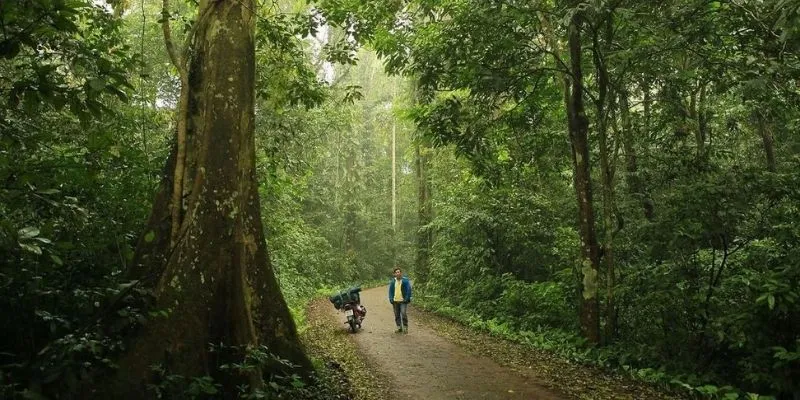
3. Xuan Son National Park
Xuan Son National Park, a hidden green gem in Phu Tho province, offers visitors a pristine, majestic natural space and unique cultural experiences of ethnic minorities. It is known for its diverse primary forest ecosystem, majestic high peaks, mysterious caves, and traditional ethnic villages.
Location:
Xuan Son National Park is located in Tan Son district, Phu Tho province, at the end of the Hoang Lien Son range, near the border area of three provinces: Phu Tho, Hoa Binh, and Son La.
How to get there:
- Motorbike: From Hanoi, you can travel by motorbike towards Son Tay, then turn left onto National Highway 32, go to Tan Son district, and follow the signs to Xuan Son National Park.
- Bus: From My Dinh bus station, there are many bus companies running the Hanoi – Xuan Son route such as Son Vi, Duy Thuan, Hai Quan.
Accommodation:
- Inside the national park: Due to its proximity to Hanoi, many visitors often choose to visit Xuan Son National Park in a day trip. However, if you want to stay overnight, you can choose homestays in Dao and Muong ethnic villages, or accommodation within the national park office grounds.
- Outside the national park: Tan Son town and nearby Viet Tri city have many guesthouses and hotels with affordable prices.
Activities and experiences:
- Explore ethnic cultural identity: Xuan Son National Park is home to communities of Dao, Muong, and Kinh ethnic groups. You can visit traditional villages such as Coi village, Ben Than village, Du village to learn about customs, housing architecture, and cultural life of local people.
- Trekking and nature exploration: Xuan Son National Park has many attractive trekking routes, taking you to explore primary forests, clear streams, and majestic waterfalls. You can also explore mysterious caves such as Son Duong cave, Tho Than cave, and Thien Nga cave.
- Stream bathing and camping: The streams in Xuan Son National Park are ideal places for you to relax and bathe in the fresh water. You can also camp by the stream or in the forest to enjoy the peaceful natural space.
- Participate in traditional festivals: If you visit Xuan Son during festival season, you will have the opportunity to participate in unique traditional festivals of ethnic minorities such as the field-opening festival, new rice festival, and crop-praying festival.
Other information:
- Ideal time to visit: The ideal time to visit Xuan Son National Park depends on your preferences. The dry season from November to April is favorable for travel, but the scenery is not as beautiful as the rainy season. The rainy season from May to October has more lush and majestic scenery, but the roads may be more difficult.
- Getting around inside the national park: The main means of transport inside Xuan Son National Park are walking and motorbikes. You can rent motorbike taxis or motorbikes from local people to move between attractions.

4. Cat Ba National Park
Cat Ba National Park, the green pearl of Cat Ba archipelago, is a harmonious combination of forest and sea, offering visitors diverse and rich experiences. It is not only famous for its diverse terrestrial forest ecosystem but also for its unique marine ecosystem with coral reefs, mangroves, and beautiful beaches.
Location:
Cat Ba National Park is located in Tran Chau commune, Cat Hai district, Hai Phong city, about 60km from Hai Phong city center and about 15km from Cat Ba town.
How to get there:
- From Hanoi to Hai Phong:
- Bus: You can take a bus to Hai Phong at Gia Lam, Yen Nghia, or Ha Dong bus stations.
- Motorbike: Travel by motorbike along National Highway 5B, about 120km (2 hours drive).
- From Hai Phong to Cat Ba:
- Ferry: Take a ferry from Dinh Vu wharf to Cai Vieng port.
- High-speed boat or hydrofoil: Take a high-speed boat or hydrofoil from Binh wharf to Binh wharf (Cat Ba).
- From Cat Ba town to Cat Ba National Park: From the center of Cat Ba town, you can travel by motorbike, car, or taxi about 15km to reach the national park.
Accommodation:
- Inside the national park: You can choose to stay overnight right inside Cat Ba National Park at the accommodation-service area of the management board or register for camping services.
- Outside the national park: Most visitors usually choose to stay overnight in Cat Ba town because there are more options for hotels, guesthouses, and homestays with better facilities and services.
Activities and experiences:
- Trekking and mountain climbing: Cat Ba National Park has many trekking and mountain climbing routes with varying lengths and difficulties, suitable for many types of visitors. Popular routes include Ao Ech – Viet Hai, May Bau – Quan Y cave, Kim Giao – Me Con – Tung Di.
- Explore forest and marine ecosystems: Cat Ba National Park has a diverse ecosystem with primary forests, secondary forests, mangroves, coral reefs, and beaches. You can explore Kim Giao forest, Ngu Lam peak, Trung Trang cave – Uy Ban cave to admire the natural beauty here.
- Swimming and participating in water sports: Cat Ba has many beautiful beaches such as Cat Co 1, 2, 3 beaches, Tung Thu beach, Duong Danh beach… You can swim, participate in water sports such as snorkeling to see coral reefs, kayaking, windsurfing…
- Visit fishing villages and experience local culture: You can visit traditional fishing villages such as Viet Hai fishing village, Cai Beo fishing village to learn about the life and culture of local people.
Other information:
- Ideal time to visit: The dry season from April to October is the best time to visit Cat Ba National Park, when the weather is dry, sunny, and the sea is calm.
- Famous sightseeing routes: Cat Ba National Park has many different sightseeing routes, from short 2-3 hour routes to long 4-8 hour routes, suitable for the time and preferences of each visitor.
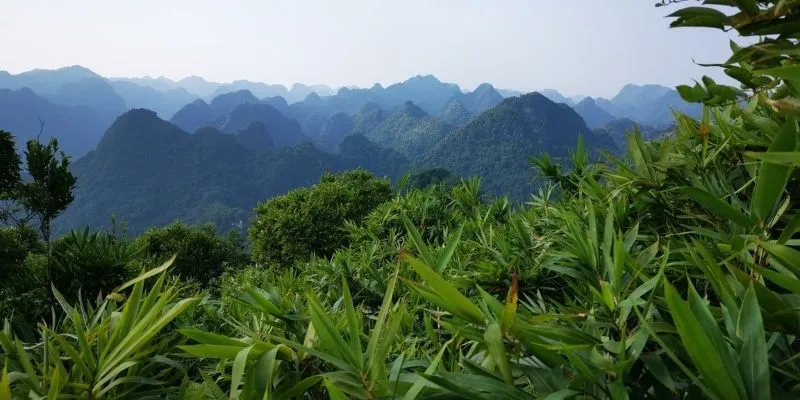
5. Tam Dao National Park
Tam Dao National Park, an ideal destination for those who want to enjoy fresh, cool air and admire the majestic natural scenery of mountains and forests. Located not far from Hanoi, Tam Dao is an excellent choice for short getaways or weekend picnics.
Location:
Tam Dao National Park stretches across three provinces: Vinh Phuc, Thai Nguyen, and Tuyen Quang, about 75km from Hanoi.
How to get there:
- Motorbike: From Hanoi, you can travel by motorbike in the direction of Thang Long – Noi Bai, to Phuc Yen, follow the direction of Vinh Yen to Tam Dao.
- Bus: Take bus route No. 58 to Me Linh Plaza, then transfer to route No. 1 to Vinh Phuc, then continue to take route No. 7 to Tay Thien and tell the driver to stop at Tam Dao National Park point. From there, you can take a motorbike taxi for a short distance to reach the destination.
- Bus (limousine): Choose Nhat Nam or Tien Thinh limousine bus companies running the Hanoi – Tam Dao route.
Accommodation:
- Inside the national park: If you want to camp in Tam Dao National Park, you need to prepare all necessary equipment and register in advance with the forest ranger station. You can also register for camping tours for more support and safety.
- Outside the national park: Tam Dao town has been developed for tourism for a long time, so there are many choices for hotels, guesthouses, and homestays with diverse price ranges.
Activities and experiences:
- Visit famous tourist attractions: Tam Dao National Park and the surrounding area have many attractive spots such as Tam Dao TV tower, Bac waterfall, Ba Chua Thuong Ngan temple, Ron Rong, pine forest…
- Trekking and mountain climbing: Tam Dao National Park has many trekking and mountain climbing routes with varying levels of difficulty. However, the routes are still quite wild and many sections are not yet trails, so it is best to go in groups with guides or join trekking tours of the national park.
- Enjoy the cool climate and natural scenery: Tam Dao is known as “Da Lat of the North” with a cool climate all year round and beautiful natural scenery. You can enjoy the fresh air, admire the rolling mountains, and lush green forests.
Other information:
- Ideal time to visit: Spring and summer are the best times to visit Tam Dao National Park, when the weather is cool and the plants are green and lush.
- Note for trekking: Trekking routes in Tam Dao are still wild and many sections are difficult to walk, so you should prepare suitable shoes and clothing, bring water and snacks, and go in groups or with a guide.
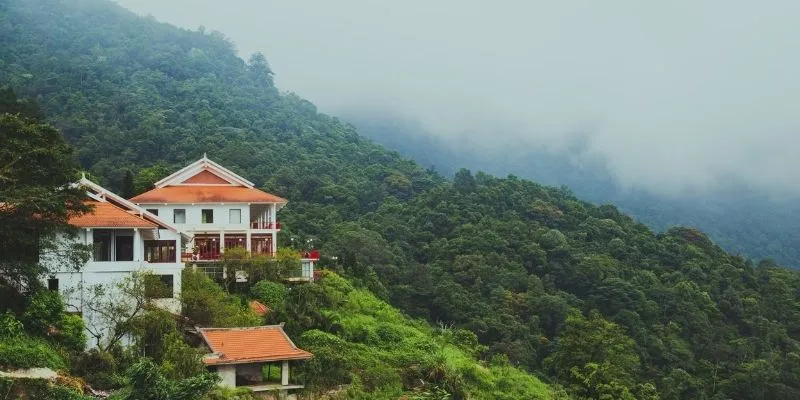
6. Xuan Thuy National Park
Xuan Thuy National Park, the first Ramsar site of Vietnam and the 50th Ramsar site in the world, is a unique destination for those who love nature and want to explore the coastal mangrove ecosystem. It is famous for its biodiversity, especially aquatic birds and migratory birds.
Location:
Xuan Thuy National Park is located in Giao Thuy district, Nam Dinh province, about 110km from Hanoi.
How to get there:
- Bus: From Giap Bat bus station, there are many bus companies running the Hanoi – Nam Dinh route.
- Motorbike: Travel by motorbike from Hanoi in the direction of Hanoi – Ninh Binh highway/CT01, about 2 hours drive.
- Train: Take a train from Hanoi station to Nam Dinh station.
From Nam Dinh city center, you need to travel another 50km to Giao Thuy district and follow the signs to Xuan Thuy National Park.
Accommodation:
- Inside the national park: Visitors can choose to stay at the park’s guesthouses inside the national park or at homestays in the community tourism village of Giao Xuan commune nearby.
- Outside the national park: Due to conservation purposes, Xuan Thuy National Park has not developed much tourism, so services and facilities are still basic. You can also bring tents and camp in the pine forest next to the clam field.
Activities and experiences:
- Bird watching and nature observation: Xuan Thuy National Park is a paradise for aquatic birds and migratory birds. The best time for bird watching is from October to April, when thousands of birds from all over the world flock here for wintering. You can take a boat tour of the national park, watch birds on the mudflats of the dunes, or watch the sunrise over the clam fields.
- Explore the mangrove ecosystem: Xuan Thuy National Park has a diverse mangrove ecosystem with mangroves, mudflats, sand dunes, and estuaries. You can take a boat to explore the mangrove forest, learn about mangrove species and animals living in this environment.
- Visit traditional craft villages: Around Xuan Thuy National Park, there are many traditional craft villages such as Sa Chau fish sauce making village, clam farming village, sedge weaving village… You can visit these craft villages to learn about the production process and buy typical products.
- Enjoy local cuisine: When visiting Xuan Thuy, don’t forget to enjoy local specialties such as nem chao, Giao Thuy spring rolls, Sa Chau fish sauce, jellyfish salad, mangrove forest honey, and fresh seafood dishes.
Other information:
- Ideal time to visit: From October to April is the best time to visit Xuan Thuy National Park, especially for bird watching enthusiasts.
- Popular activities: Boat tour of the national park, bird watching, exploring the mangrove ecosystem, visiting traditional craft villages, enjoying local cuisine.
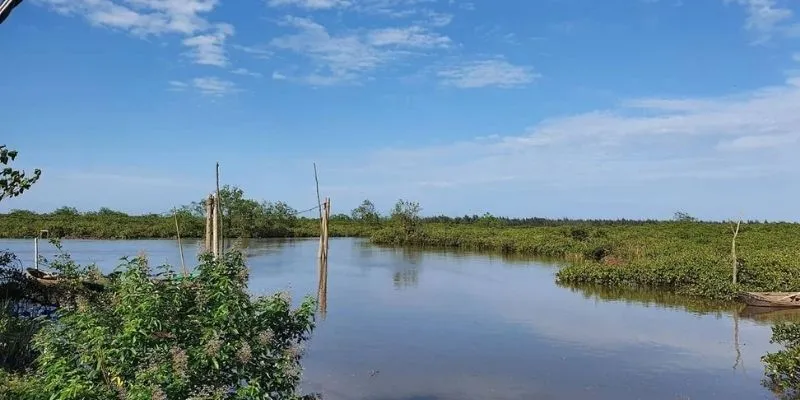
7. Phong Nha – Ke Bang National Park
Phong Nha – Ke Bang National Park, a UNESCO World Natural Heritage site, is one of the most attractive destinations in Vietnam. It is famous for its magnificent, diverse, and rich cave system, along with pristine, majestic natural landscapes and unique geological and geomorphological values.
Location:
Phong Nha – Ke Bang National Park is located in Quang Binh province, about 50km northwest of Dong Hoi city.
How to get there:
To get to Phong Nha – Ke Bang, you need to reach Dong Hoi city first. From Hanoi or Ho Chi Minh City, you can choose to travel to Dong Hoi by plane, train, or bus.
- From Dong Hoi to Phong Nha – Ke Bang:
- Bus: Bus route B4 from the center of Dong Hoi to Phong Nha.
- Motorbike: Travel by motorbike for about 45-60 minutes.
- Taxi or car rental with driver: Hire a taxi or car with a driver if traveling in a large group or family.
Accommodation:
- Inside the national park: Currently, you can only camp in certain areas through licensed exploration tours.
- Outside the national park: Phong Nha and Dong Hoi areas have many diverse accommodation options, from homestays, budget guesthouses to luxury hotels and resorts.
Activities and experiences:
- Explore the cave system: Phong Nha – Ke Bang National Park has hundreds of large and small caves, the most famous of which are Phong Nha cave, Paradise cave, Tien Son cave, Son Doong cave… You can join cave exploration tours to admire the magnificent beauty of creation.
- Visit ecotourism sites: In addition to caves, Phong Nha – Ke Bang also has many attractive ecotourism sites such as Mooc spring tourist area, Chay river – Dark cave, Sinh Ton valley – Thuy Cung cave…
- Participate in adventure sports activities: Phong Nha – Ke Bang is an ideal destination for those who love adventure sports activities such as jungle trekking, ziplining, kayaking, cave swimming…
- Learn about local culture and history: Quang Binh is a land rich in historical and cultural traditions. You can visit historical sites such as Dong Hoi Citadel, Luy Thay, or learn about the culture of local people through traditional craft villages and festivals.
Other information:
- Ideal time to visit: From April to August is the best time to visit Phong Nha – Ke Bang, when the weather is dry, sunny, and with less rain.
- Opening hours: 7:00 AM – 5:00 PM daily.
- Getting around inside the national park: Means of transport inside the national park are diverse, including trekking, boat, kayak, motorbike, car…
- Culinary specialties: When visiting Phong Nha – Ke Bang, don’t forget to enjoy local specialties such as eel, grilled stream fish, forest bamboo shoots, fish hotpot with vegetables, and fresh seafood dishes.
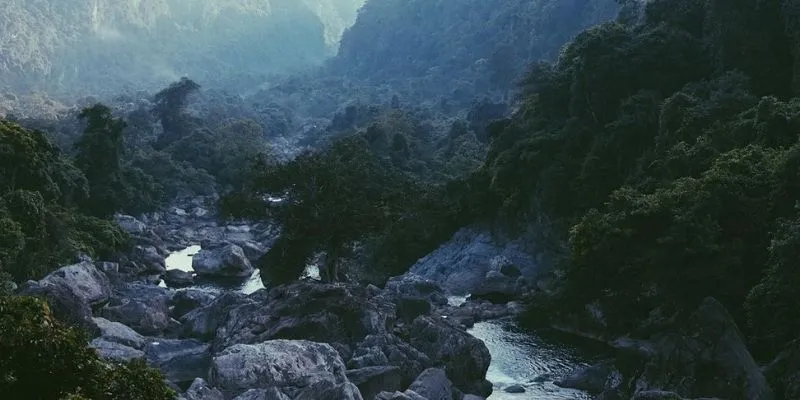
8. Bach Ma National Park
Bach Ma National Park, a precious gem of Central Vietnam, is famous for its year-round cool climate, diverse and abundant natural landscapes, along with special historical and cultural values. It is an ideal destination for those who want to find peace, relaxation, and explore the pristine beauty of mountains and forests.
Location:
Bach Ma National Park is located between the border of Thua Thien Hue province and Da Nang city, about 40km from Hue city.
How to get there:
From Hue or Da Nang, you can travel to Bach Ma National Park by motorbike, taxi, or rental car.
- From Hue: Head towards Da Nang, onto National Highway 1A, to Phu Loc commune and follow the signs to Bach Ma.
- From Da Nang: Head towards Hai Van pass onto National Highway 1A and follow the instructions as above.
Accommodation:
- Inside the national park: Bach Ma National Park has many flat locations suitable for daytime camping. If you want to stay overnight, you can choose Do Quyen villa on Bach Ma mountain peak.
- Outside the national park: The foot of Bach Ma mountain and the national park entrance area have many homestays, hotels, and guesthouses with diverse price ranges.
Activities and experiences:
- Visit famous tourist attractions: Bach Ma National Park has many attractive spots such as Hai Vong Dai peak with panoramic views, Ngu Ho with a system of 5 beautiful natural lakes, majestic Do Quyen waterfall, ancient French villas imbued with historical marks…
- Trekking and nature exploration: Bach Ma National Park has many trekking and long-distance hiking routes with varying lengths and difficulties. You can choose routes such as the path to Bach Ma peak, the path to Do Quyen waterfall, the forest trail…
- Bird watching and wildlife observation: Bach Ma is home to many rare and precious flora and fauna species, especially birds. You can join bird watching tours to observe the diverse and abundant bird species of the national park.
- Enjoy the cool climate and natural scenery: With a cool climate all year round and beautiful natural scenery, Bach Ma is an ideal destination for you to relax, rest, and immerse yourself in nature.
Other information:
- Ideal time to visit: From December to April is the best time to visit Bach Ma National Park, when the weather is dry, cool, and with less rain.
- Opening hours: 7:00 AM – 5:00 PM daily.
- Getting around inside the national park: The main means of transport inside the national park are trekking and rental cars. You can rent a car to travel on the main road of the national park.
- Note: The road to Bach Ma peak is quite steep and winding, you should drive carefully and check your car thoroughly before going.

9. Cat Tien National Park
Cat Tien National Park, one of UNESCO’s world biosphere reserves, is an attractive destination for those who love exploring wild nature and learning about biodiversity. It is famous for its diverse and rich tropical rainforest ecosystem, along with many rare and precious flora and fauna species and beautiful natural landscapes.
Location:
Cat Tien National Park is located in three provinces: Dong Nai, Lam Dong, and Binh Phuoc, about 160km from Ho Chi Minh City.
How to get there:
- Motorbike: Go along National Highway 1A to Dau Giay intersection, turn left onto National Highway 20, go about 58km to Ta Lai intersection, turn left following the signs and go about 24km further to Cat Tien National Park.
- Bus: Kim Hoan bus company at counter number 5 of Mien Dong bus station has a bus route to Cat Tien National Park.
Accommodation:
- Inside the national park: Currently, visitors can stay overnight at Bau Sau but the number is limited, so register in advance to reserve a spot.
- Outside the national park: The area near the entrance of Cat Tien National Park and along the forest, along the river has many hotels, homestays, and farmstays with diverse price ranges.
Activities and experiences:
- Explore the diverse forest ecosystem: Cat Tien National Park has a diverse and rich tropical rainforest ecosystem, with many ancient trees, vines, and endemic plants. You can join forest hiking tours to explore the beauty of Cat Tien forest.
- Wildlife observation: Cat Tien is home to many rare and precious wild animals such as the Javan rhinoceros, elephant, gaur, Asiatic black bear, black-shanked douc langur, and pygmy slow loris… You can join wildlife observation tours at night or during the day for a chance to encounter these animals.
- Visit Bau Sau: Bau Sau is a large wetland located in Cat Tien National Park, home to many Siamese crocodiles. You can take a boat tour of Bau Sau and observe crocodiles in their natural environment.
- Camping and picnicking: Cat Tien National Park has many areas suitable for camping and picnicking. You can camp by the Dong Nai river or in the forest to enjoy the peaceful natural space.
Other information:
- Ideal time to visit: The dry season from December to May is the best time to visit Cat Tien National Park, especially the purple flamboyant season from April to May.
- Getting around inside the national park: Means of transport inside the national park include trekking, bicycles, and jeeps. You need to register at the entrance if you want to use car services.
- Culinary specialties: When visiting Cat Tien, don’t forget to enjoy local specialties such as snakehead fish, forest perch, water lily soup, river fish hotpot with forest vegetables, and dishes made from forest vegetables.
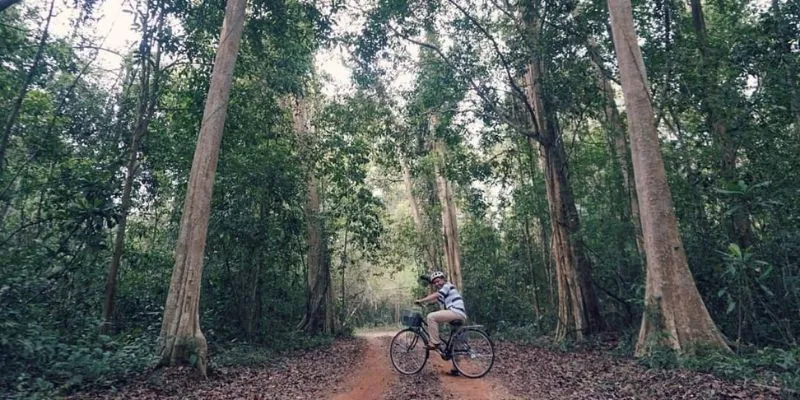
10. Phu Quoc National Park
Phu Quoc National Park, occupying a large part of Phu Quoc island, is an attractive destination for those who want to explore the pristine beauty of forests and sea. It is famous for its diverse primary forest ecosystem, beautiful beaches, clear streams, and majestic mountains.
Location:
Phu Quoc National Park is located in the north of Phu Quoc island, Kien Giang province, including the North Island Nature Reserve, Ham Rong mountain area, Ganh Dau, and Cua Can.
How to get there:
To get to Phu Quoc, you can travel by plane from Hanoi or Ho Chi Minh City to Phu Quoc airport.
- From Phu Quoc airport to Phu Quoc National Park: You can travel by taxi, motorbike taxi, or bus to different locations on Phu Quoc island to start exploring the national park. The most convenient and reasonable place to start exploring the national park is Bai Thom. From the center of Duong Dong town, go north to Nguyen Trung Truc street, go about 16km further to the signpost at Duong Dong – Bai Thom intersection. From here, follow the instructions for about 6km to reach the center of Nui Chua National Park.
Accommodation:
- Inside the national park: For conservation and safety purposes, visitors to Phu Quoc National Park are only allowed to camp during the day and are not allowed to stay overnight inside the national park.
- Outside the national park: Phu Quoc has many diverse accommodation options, from luxury resorts, high-class hotels to budget guesthouses and nature-friendly homestays.
Activities and experiences:
- Trekking and mountain climbing: Phu Quoc National Park has many trekking and mountain climbing routes with varying levels of difficulty, taking you to explore primary forests, high peaks, and clear streams. You can conquer Chúa mountain peak, the highest mountain in Phu Quoc, to admire the panoramic view of the pearl island from above.
- Explore streams and waterfalls: Phu Quoc National Park has many beautiful streams and waterfalls such as Tranh stream, Da Ngon stream, Gio waterfall… You can swim in streams, picnic by the streamside, or explore the pristine beauty of the waterfalls.
- Visit beaches and fishing villages: Phu Quoc is famous for its beautiful beaches such as Truong beach, Sao beach, Kem beach, Dai beach… You can swim, participate in water sports, or visit traditional fishing villages to learn about the life of local people.
- Snorkeling to see coral reefs: The sea area of Phu Quoc has many beautiful and biodiverse coral reefs. You can join snorkeling tours to explore the magical ocean world.
Other information:
- Ideal time to visit: From December to April is the best time to visit Phu Quoc National Park, when the weather is dry, sunny, and the sea is calm. If you want to experience stream bathing, you should go in the rainy season, but the roads will be more treacherous and difficult to travel.
- Famous attractions: Tranh stream, Da Ngon stream, Chúa mountain, Thiên Đường mountain, beautiful beaches, traditional fishing villages.
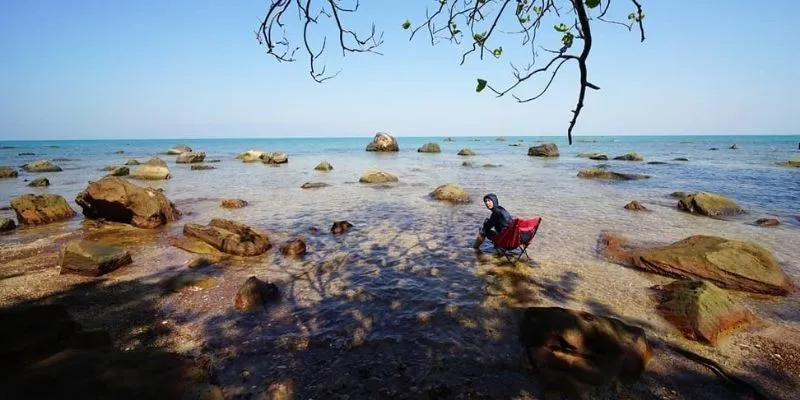
Trips and trekking in the top 10 most beautiful national parks in Vietnam promise to bring you memorable experiences and surprising discoveries about the majestic natural beauty of the country. Get ready for your health and plan a journey to explore these wonderful national parks right away! Don’t forget to book air tickets, train tickets, and accommodation on “Du lịch khắp thế gian” to make your trip simpler and more convenient!